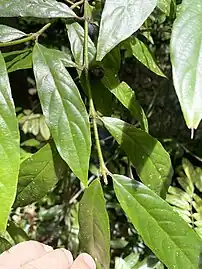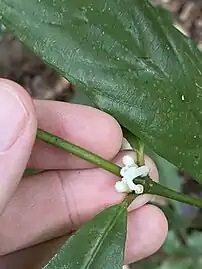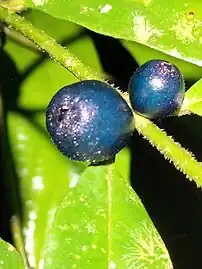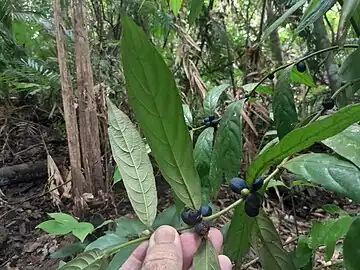| Blue rubi | |
|---|---|
 | |
| Scientific classification | |
| Kingdom: | Plantae |
| Clade: | Tracheophytes |
| Clade: | Angiosperms |
| Clade: | Eudicots |
| Clade: | Asterids |
| Order: | Gentianales |
| Family: | Rubiaceae |
| Genus: | Lasianthus |
| Species: | L. chlorocarpus |
| Binomial name | |
| Lasianthus chlorocarpus | |
| Synonyms[3] | |
| |
Lasianthus chlorocarpus, commonly known as blue rubi, is a plant in the family Rubiaceae native to parts of Malesia, Papuasia and Australia. It is an evergreen shrub growing up to 2 m (6 ft 7 in) high in well developed rainforest.[4]
Description
Lasianthus chlorocarpus is an understorey shrub of rainforest habitats, growing up to 2 m (6 ft 7 in) in height.[4] The leaves are simple and opposite, glabrous above and finely hairy below. They are long and narrow − up to 19 cm (7.5 in) by 5 cm (2.0 in) − with smooth margins.[4][5] They have around eight pairs of lateral veins which curve strongly and run almost parallel to the leaf margin, but do not form loops with the following pair.[4]
The flowers are produced in the leaf axils and are about 10 mm (0.39 in) in diameter with 4 or 5 white petals.[5] The fruit is an ovoid drupe up to 16 mm (0.63 in) long by 12 mm (0.47 in) wide, dark blue or blackish, with the green calyx persitant at the apex.[4][5] Fine hairs cover the outer surface, giving it a shiny appearance.[5] They usually contain four seeds about 6 mm (0.24 in) long by 3 mm (0.12 in) wide.[4][5]
Phenology
In Australia flowering occurs almost year-round from April to February, and similarly fruit ripen from February to December.[5]
Taxonomy
This species was described in 1905 by Karl Moritz Schumann in the book Nachträge zur Flora der deutschen Schutzgebiete in der Südsee which he co-authoured with Carl Adolf Georg Lauterbach. The description was based on material collected in 1896 by Lauterbach in "Kaiser-Wilhelmsland" (the northern part of present day Papua New Guinea).[6]
In Australia, the name Lasianthus strigosus was misapplied to this species in the past.[4][5][7]
Distribution and habitat
The natural range of the blue rubi includes Sulawesi and the Lesser Sunda Islands, the Philippines, New Guinea and the Solomon Islands, and Queensland.[3] In Queensland it is found in the northeastern coastal forests, in three small pockets in the northern half of Cape York Peninsula, and a much larger concentration between Rossville and Tully.[8]
It grows in well developed rainforest, at altitudes from sea level to 500 m (1,600 ft).[4]
Conservation
This species is listed by the Queensland Department of Environment and Science as least concern.[1] As of 4 April 2023, it has not been assessed by the International Union for Conservation of Nature (IUCN).
Gallery
 Foliage
Foliage Flowers
Flowers Fruit
Fruit Foliage and fruit
Foliage and fruit
References
- 1 2 "Species profile—Lasianthus chlorocarpus". Queensland Department of Environment and Science. Queensland Government. 2022. Retrieved 4 April 2023.
- ↑ "Lasianthus chlorocarpus". Australian Plant Name Index (APNI). Centre for Plant Biodiversity Research, Australian Government. Retrieved 4 April 2023.
- 1 2 3 "Lasianthus chlorocarpus K.Schum". Plants of the World Online. Royal Botanic Gardens, Kew. Retrieved 4 April 2023.
- 1 2 3 4 5 6 7 8 F.A.Zich; B.P.M.Hyland; T.Whiffen; R.A.Kerrigan (2020). "Lasianthus chlorocarpus". Australian Tropical Rainforest Plants Edition 8 (RFK8). Centre for Australian National Biodiversity Research (CANBR), Australian Government. Retrieved 4 April 2023.
- 1 2 3 4 5 6 7 Cooper, Wendy; Cooper, William T. (June 2004). Fruits of the Australian Tropical Rainforest. Clifton Hill, Victoria, Australia: Nokomis Editions. p. 444. ISBN 9780958174213.
- ↑ Schumann, K.M.; Lauterbach, C.A.G. (1905). Nachträge zur Flora der deutschen Schutzgebiete in der Südsee. Leipzig: Gebrüder Borntraeger. p. 399. Retrieved 4 April 2023.
- ↑ "Lasianthus chlorocarpus". Australian Plant Census (APC). Centre for Plant Biodiversity Research, Australian Government. Retrieved 4 April 2023.
- ↑ "Search: species: Lasianthus chlorocarpus | Occurrence records". Australasian Virtual Herbarium. Australian Government. Retrieved 5 April 2023.
External links
 Data related to Lasianthus chlorocarpus at Wikispecies
Data related to Lasianthus chlorocarpus at Wikispecies Media related to Lasianthus chlorocarpus at Wikimedia Commons
Media related to Lasianthus chlorocarpus at Wikimedia Commons- View a map of historical sightings of this species at the Australasian Virtual Herbarium
- View observations of this species on iNaturalist
- View images of this species on Flickriver